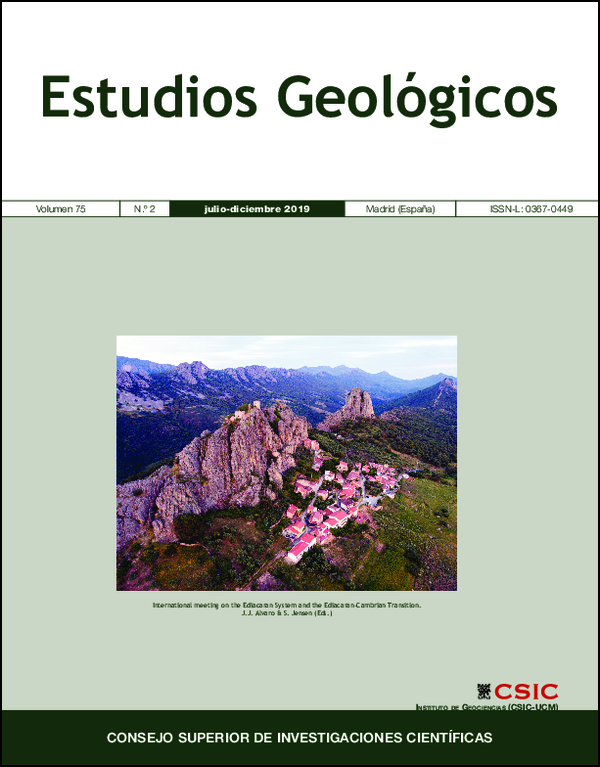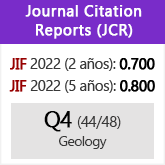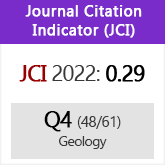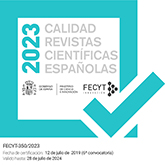Nuevo registro de la biota ediacárica en la Arenisca de Jodhpur (Supergrupo de Marwar), Rajasthan occidental, India
DOI:
https://doi.org/10.3989/egeol.43590.563Palabras clave:
Arenisca de Jodhpur, Metazoos de cuerpo blando, Estructuras microbianas, EdiacáricoResumen
En el oeste de Rajasthan, India, la Arenisca de Jodhpur (Supergrupo de Marwar) ha librado un nuevo conjunto fósil ediacárico que comprende especímenes macroscópicos bien conservados de Aspidella, Hiemalora, grandes discos ediacáricos, Tirasiana disciformis, asteroides de Medusinites, fósiles de cuerpo blando ediacáricos similares a Anfesta y estructuras de tapices microbianas (Arumberia banksi, estructuras microbianas de tipo Kinneyia, estructuras microbianas arrugadas y otras estructuras microbianas). El registro fósil permite sugerir una amplia correlación con la Formación de Fermuse, Terranova, Australia meridional, el Mar Blanco de Rusia y Noruega, y la correlación regional con el Grupo de Bhander (Supergroup de Vindhyan) y el Grupo de Krol del Himalaya Interior.
Descargas
Citas
Billings, E. (1872). On some fossils from the Primordial rocks of Newfoundland. Canadian Naturalist, 6: 465-479. https://doi.org/10.5962/bhl.title.38279
Chauhan, D.S.; Mathur, K.M. & Narayan Ram (2001). Geological nature of the Pokaran boulder Bed: Palaeoenvironment, Palaoclimatic and Stratigraphic Implication. Journal of the Geological Society of India, 58: 425-433.
Chauhan, D.S.; Bhanwara Ram & Narayan Ram (2004). Jodhpur Sandstone: A gift of Ancient Beaches of Western Rajasthan. Geological Society of India, 64: 265-276.
Fedonkin, M.A. (1980). New Precambrian Coelenterata in the north of the Russian platform. Paleontological Journal, 14: 1-10.
Fedonkin, M.A. (1987). The non-skeletal fauna of the Vendian and its place in the evolution of the Metazoa. Trudy Paleontologiceskogo Instituta Akademia Nauk SSSR, 226: 1-174.
Fedonkin, M.A. (1992). Vendian faunas and the early evolution of the Metazoa. In: Origin and Early Evolution of the Metazoa (Lipps, J.H. & Signor, P.W., Eds.). Plenum, New York, 87-129. https://doi.org/10.1007/978-1-4899-2427-8_4
Gehling, J.G. (1999). Microbial mats in Terminal Proterozoic siliciclastic Ediacaran death masks. Palaios, 14: 40-57. https://doi.org/10.2307/3515360
Gehling, J.G.; Narbonne, G.M. & Anderson, M.M. (2000). The first named Ediacaran body fossil, Aspidella terranovica. Palaeontology, 43: 427-456. https://doi.org/10.1111/j.0031-0239.2000.00134.x
Glaessner & Walter, M.R. (1975). New Precambrian fossils from the Arumbera Sandstone, Northern Territory, Australia. Alcheringa, 1: 56-69. https://doi.org/10.1080/03115517508619480
Gregory, L.C.; Meert, J.G.; Bingen, B.H. Pandit, M.K. & Torsvik, T.H. (2009). Paleomagnetic and geochronologic study of Malani Igneous suite, NW India: implications for the configuration of Rodinia and the assembly of Gondwana. Precambrian Research, 170: 13-26. https://doi.org/10.1016/j.precamres.2008.11.004
Hagadorn, J.W.; Fedo, C.M. & Waggoner, B.M. (2000). Early Cambrian Ediacaran-type fossils from California. Journal of Paleontology, 74: 731-740. https://doi.org/10.1666/0022-3360(2000)074<0731:ECETFF>2.0.CO;2
Kumar, V. & Chandra, R. (2005). Geology and evolution of Nagaur - Ganganagar Basin with special reference to salt and potash mineralization. Geological Survey of India Special Publication, 62: 1-151.
Kumar, S. & Pandey, S.K. (2009). Note on the occurrence of Arumberia and associated fossils from the Jodhpur Sandstone, Marwar Supergroup, Western Rajasthan. Journal Palaeontological Society of India, 54: 171-178.
McCall, G.J.H. (2006). The Vendian (Ediacaran) in the geological record: Enigmas in geology's prelude to the Cambrian explosion. Earth-Science Reviews, 77: 1-229. https://doi.org/10.1016/j.earscirev.2005.08.004
Narayan Ram & Chauhan, D.S. (2007). The Jodhpur sandstone of Bhopalgarh area: Its geological nature and environment of deposition. Emerging trends of research in Geology, NW India (Avadich, P.C. & Bhu, H., Eds.). MLSU, Udaipur (Rajastan), 89-103.
Noffke, N. (2010). Geobiology: Microbial Mats in Sandy Deposit from the Archean Era to Today. Springer Heidelberg.
Noffke, N.; Gerdes, G.; Klenke T. & Krumbein, W.E. (2001). Microbially induced sedimentary structures - a new category within the classification of primary sedimentary structures. Journal of Sedimentary Research, 71: 649-656. https://doi.org/10.1306/2DC4095D-0E47-11D7-8643000102C1865D
Palij, V.M. (1976). Palaeontologiya i Stratigrafiya Verkhnego Kembriya i Nizhnego Paleozoya Yugo-Zapada Vostochno-Evröpeiskoi Platformy. Kiev, Naukova dumka, 63-77.
Pandey, D.K. & Bahadur, T. (2009). A Review of the Stratigraphy of Marwar Supergroup of west- central Rajasthan. Journal Geological Society of India, 73: 747-758. https://doi.org/10.1007/s12594-009-0060-6
Pareek, H.S. (1981). Configuration and sedimentary stratigraphy of western Rajasthan. Journal of the Geological Society of India, 22: 517-523.
Pareek, H.S. (1984). Pre-Quarternary geology and mineral resources of north- western Rajasthan. Memoirs of the Geological Survey of India, 115: 1-99.
Parihar, V.S.; Gaur, V. & Nama, S.L. (2012). Trace fossils and microbial-mat Induced sedimentary structures from the Girbhaker sandstone of Marwar Super group, Bhopalgarh, Jodhpur, Rajasthan, India. Journal of Earth Science and Climate Change, S12: 002. https://doi.org/10.4172/2157-7617.S12-002
Raghav, K.S.; De, C. & Jain, R.L. (2005). The first record of Vendian medusoids and trace fossil bearing algal mat ground from the basal part of the Marwar Supergroup of Rajasthan, India. Indian Minerals, 59: 23-30.
Sarkar, S.; Bose, P.K.; Samantha, P.; Sengupta, P. & Eriksson, P. (2008). Microbial mat mediated structures in the Ediacaran Sonia Sandstone, Rajasthan, India and their implications for Proterozoic sedimentation. Precambrian Research, 162: 248-263. https://doi.org/10.1016/j.precamres.2007.07.019
Sprigg, R.C. (1949). Early Cambrian "jellyfishes" at Ediacara, South Australia and Mount John, Kimberley District, Western Australia. Transactions of the Royal Society of South Australia, 73: 72-99.
Srivastava, P. (2012). Ediacaran discs from the Jodhpur Sandstone, Marwar Supergroup, India: a biological diversification or taphonomic interplay? International Journal of Geosciences, 3: 1120-1126. https://doi.org/10.4236/ijg.2012.35113
Wade, M. (1972). Hydrozoa and Scyphozoa and other medusoides from the Precambrian, Ediacara Fauna, South Australia. Palaeontology, 15: 197-225.
Walcott, C.D. (1916). Cambrian geology and paleontology III, No. 2 - Precambrian Algonkian algal flora. Smithsonian Miscellaneous Collections, 64: 77-156.
Publicado
Cómo citar
Número
Sección
Licencia
Derechos de autor 2019 Consejo Superior de Investigaciones Científicas (CSIC)

Esta obra está bajo una licencia internacional Creative Commons Atribución 4.0.
© CSIC. Los originales publicados en las ediciones impresa y electrónica de esta Revista son propiedad del Consejo Superior de Investigaciones Científicas, siendo necesario citar la procedencia en cualquier reproducción parcial o total.Salvo indicación contraria, todos los contenidos de la edición electrónica se distribuyen bajo una licencia de uso y distribución “Creative Commons Reconocimiento 4.0 Internacional ” (CC BY 4.0). Puede consultar desde aquí la versión informativa y el texto legal de la licencia. Esta circunstancia ha de hacerse constar expresamente de esta forma cuando sea necesario.
No se autoriza el depósito en repositorios, páginas web personales o similares de cualquier otra versión distinta a la publicada por el editor.

















